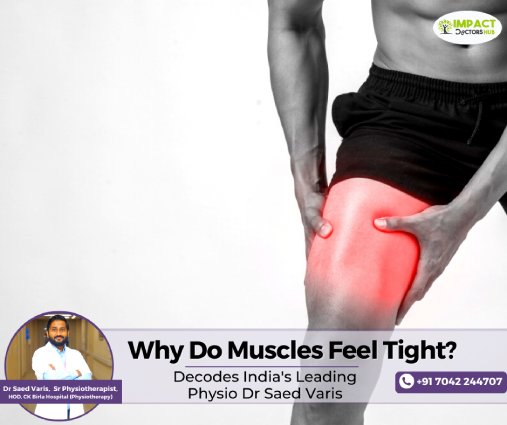
When a person says they feel tight in a specific area, they may be referring to multiple different complaints. It might be:
- A poor range of motion
- Motion is normal but a movement to the end feels uneasy
- Or a vague sense of discomfort
This doubt means that the feeling of tightness is simply that – a feeling – which is not a similar thing as the physical or mechanical property of excess tension, stiffness, or shortness. You may have one without the other says physiotherapist Dr Saed Varis.
Reasons muscles feel tight, but actually, they are not
One can use pain as an analogy. Pain could exist even in the absence of tissue damage, since, pain results from the perception of threat, and perception does not always match reality. Pain is importantly an alarm, and alarms sometimes go off even when there is no real danger.
Probably a similar logic is involved in the feeling of tightness. The feeling happens when you unconsciously perceive (rightly or wrongly) that there is a threatening condition in your muscles that needs movement correction. So, the tension in muscles is not a real threat but the lack of rest of blood flow is a threat. Pain might not be too much but it could be bothersome. So how can one cure this issue? Below Gurugram’s top physiotherapist Dr Saed Varis shares a list of various methods that are often used to address the chronic feeling of tightness.
Stretching
We instinctively stretch muscles that have stayed in a short position for a while, and this normally makes us feel instantly better. But, people suffering from chronic tightness have already tried and failed at this strategy, which indicates the issue is less about bad mechanics and more about enhanced sensitivity. The issue is that many several people, and indeed multiple therapists, will think that the failure of a few easy stretches indicates the requirement for a far more aggressive program.
This may of course make sense if the root of the problem was short or adhered tissues. But if the root problem has actually increased sensitivity, then aggressive stretching could just make the problem worse. On the other hand, stretching can mostly have an analgesic and relaxing effect. So is stretching a good method to cure tightness? Like with several things, if it feels good do it. If it doesn’t then stop.
Soft tissue work for tightness
There are several soft tissue treatments (deep tissue massage, foam rolling, Graston, ART, IASTM) targeted to lengthen short tissues, break adhesions, or melt fascia, and others. This is quite likely impossible.
But these treatments could decrease sensitivity and make someone feel less tight. Certainly, by activating descending inhibition of nociception, which is a well-known impact of painful stimulation that is supposed to bring health benefits. But definitely, these treatments also form nociception, which tends to boost sensitivity. It is a fine balance that depends on an individual and several other variables. Again, if it feels good do it, but it is an option, not a necessity, it is only temporary, and you must keep in mind the reason for doing it.
Motor control for muscle tightness
Several forms of movement therapy are essentially motor control methods – they seek to alter movement, postural and breathing habits so they are more efficient, eradicate parasitic tension, form the skill of relaxation, etc. Habits are difficult to break, but this strategy is worth a try, particularly, in cases where tightness seems linked to certain postures or movements. Certainly, where the situation is more complex, motor control must not be expected to fix the problem on its own.
Exercise and resistance training
People tend to link strength training with becoming tighter. During exercise, muscles surely, become very tense, and they might feel stiff the next day because of delayed onset muscle soreness. There is also the (false) notion that strength training makes muscles shorter and less flexible.
These issues are unfounded. In fact, a complete range of motion strength training could increase flexibility, probably more than stretching. It makes local adaptations in muscles that might improve endurance and make them less prone to suffer metabolic distress. And exercise also has an analgesic impact and can reduce levels of inflammation that makes the nervous system sensitive.
Also, if you overwork your muscles from strength training and do not let them recover, they will get sensitive, stiff, and sore. But if you work them the adequate amount – enough to form an adaptation and not too much to cause injury or prevent complete recovery – then you will make them healthier, stronger, and also – less stiff.
P.S. The information provided above is a general one. It is advised to seek a professional physiotherapist’s input before starting any muscle-strengthening exercises on your own. If you need a top physio’s advice, you are free to consult with India’s leading physiotherapist Dr. Saed Varis who heads Gurugram’s leading physiotherapy clinic the Impact Doctors Hub.


